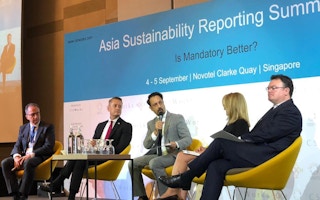A bugbear of businesses, when it comes to sustainability reporting, is the plethora of standards they need to comply with to show stakeholders and stock markets that they are good corporate citizens.
But efforts to harmonise standards have taken a step back following a heated debate between the chief executives of two of the world’s most widely used sustainability reporting standards at an event in Singapore this week.
At a panel session at the Asia Sustainability Reporting Summit on Wednesday, Tim Mohin, CEO of market-leading standard Global Reporting Initiative (GRI), and Madelyn Antoncic, CEO of New York-headquartered Sustainability Accounting Standards Board (SASB), traded barbs over whose was the superior standard.
“
We don’t have enough time for a Darwinian contest to determine the standard fittest to survive.
Stefan Ullrich, director of sustainable finance, Paia Consulting
The contretemps took place a few weeks before the Corporate Reporting Dialogue, a multi-stakeholder platform involving GRI and SASB that aims to create consistency among reporting frameworks, is to publish a landmark study on how different players can work towards a single standard.
At the summit, Antoncic—a former executive at the World Bank, Goldman Sachs and Lehman Brothers who was appointed SASB’s CEO eight months ago—fired the first salvo, calling GRI too difficult for investors to understand and hard for companies to compare their performance with their peers.
Mohin countered that GRI is used by 75 per cent of the world’s largest companies and 80 per cent of big firms in Southeast Asia, where the non-profit opened a Singapore operation earlier this week.
Speaking to Eco-Business a day after the summit, Mohin said: “With those numbers, I don’t see how what SASB is saying can be true.”
He added: “When I first took this job [in 2017], I sat down with SASB and we agreed that competition between us is not helpful. We are both aiming for the same thing—to align capital with sustainable business practices—and the two approaches are complementary. That was the dialogue, up until yesterday. Now there’s been a change.”
Material world
The main difference between GRI and SASB is their approach to materiality—how companies report environmental, social and governance (ESG) issues that are the most relevant to their business, which forms the backbone of sustainability reporting.
GRI, which launched in 1997, defines what companies should report based on what matters to a broad group of stakeholders, and asks companies to consider what their biggest impacts on society, the environment and the economy are.
SASB, which emerged out of the accounting profession in 2011, is more focused on incorporating material sustainability information that investors and shareholders need to make the right decisions.
“SASB’s definition of materiality is any issue that could impact a company’s finances. Our definition of materiality is the company’s impact on the world around it,” Mohin explained. “SASB is inward-looking, GRI is outward-looking.”
Antoncic said that SASB’s standard provides “financially material, industry specific” information which investors can plug straight into a Bloomberg financial information terminal, whereas GRI’s definition of materiality is broad, making comparisons between companies and sectors difficult.
“If GRI was supplying perfect information to investors there would be no opportunity for others like us to develop,” said Antoncic, adding that SASB would be launching a presence in Asia in the near future.
“
Whether we can get back to common ground is anyone’s guess.
Tim Mohin, chief executive, Global Reporting Initiative
No best way
Sustainability consultants agreed that GRI’s and SASB’s standards are complementary and can co-exist.
“We don’t have enough time for a Darwinian contest to determine the standard fittest to survive,” said Stefan Ullrich, director of sustainable finance at Paia Consulting, which has an office in Singapore.
There is “no one best way” and the standard a company chooses will depend on the scenario, said Thomas Milburn, director of Southeast Asia for sustainability reporting consultancy Corporate Citizenship.
If, for instance, a palm oil company is asked for sustainability information by buyers, green groups, the media or regulators, GRI is best placed to meet those needs. But if that company needs information purely for a financial report, SASB is the better option, said Milburn.
Besides the two standards, other frameworks such as International Integrated Reporting Council (IIRC), CDP (formerly the Carbon Disclosure Project) and Task Force on Climate-related Financial Disclosures (TCFD) are crowded into the reporting picture, said Milburn.
“The current landscape is confusing and can be very burdening for companies,” he said.
Expressing hope that the Corporate Reporting Dialogue would bring more alignment and consistency to sustainability reporting, Milburn added: “If everyone is pulling in different directions, they are not leading us to useful disclosures that help stakeholders make better decisions, which ultimately affects the sustainable development of the whole world.”
Investor frustration with the raft of reporting standards is not a new issue. A 2016 survey by professional services firm PwC found that less than a third (29 per cent) of investors are confident in the quality of ESG information they get from companies to navigate sustainability-related risks.
In an interview with Eco-Business last month, Peter Bakker, chief executive of the World Business Council for Sustainable Development, said that the number of sustainability reports companies must complete “is totally out of hand” and called for consolidation in the reporting space as a matter of urgency.
Mohin acknowledged that his exchange with Antoncic in Singapore was a “step backwards” in bringing greater consistency to sustainability reporting. “Whether we can get back to common ground is anyone’s guess at this point,” he said.
Antoncic said that SASB would be happy to collaborate with GRI, but would not change its principles. “Ours are financial materiality, theirs are not. Ours are industry specific, theirs are not. We are about comparability, they are not,” she said.

















